Whether you’re pining to bask in B.C.’s natural beauty or take a deep dive into the province’s rich history, the Gold Rush Trail is widely considered one of the most significant ways to experience everything that makes B.C. beautiful - and there’s no better time to travel it than in the fall.
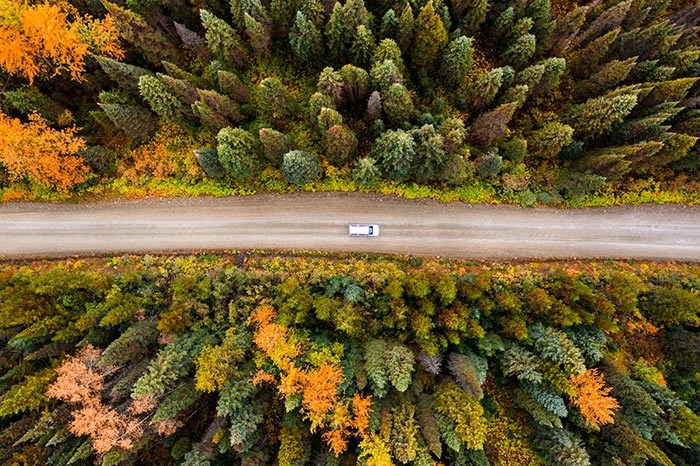 Photo: @tylermcave, provided by Cariboo Chilcotin Coast Tourism Association
Photo: @tylermcave, provided by Cariboo Chilcotin Coast Tourism Association
Originally a travel route for those with dreams of finding gold and “striking it rich”, today’s Gold Rush Trail serves as an experiential corridor; a journey of stories, people, activities and places that every British Columbian should experience at least once in their lifetime. Just as many adventurers did before us, travellers can still come seeking the riches of the region, however this time gold is not the only treasure to be found.
In fact, there are literally dozens of jaw-dropping destinations that punctuate the entirety of the travel route. With that in mind, we’ve partnered with the Gold Rush Trail and the Cariboo Chilcotin Coast to highlight the trail’s most sought after stops. From hidden gems to natural wonders, these are a few of the must-visit stops on B.C.’s Gold Rush Trail this fall.
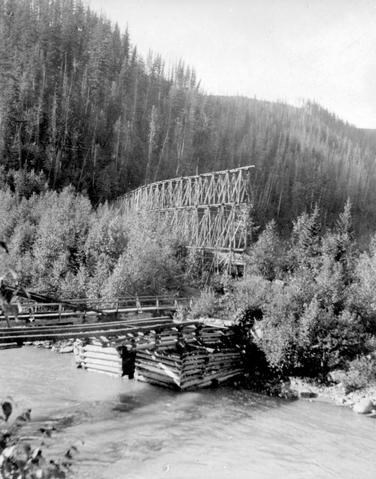 Quesnelle Forks, B.C. Archives, Photo provided by Land Without Limits
Quesnelle Forks, B.C. Archives, Photo provided by Land Without Limits
First things first, a little backstory…
In 1857, gold was discovered in the Fraser River and in the spring of 1858, James Douglas sent 800 ounces of gold to the San Francisco Mint. Rumours of a new gold rush quickly begin to spread and in April of 1858, thousands made the journey up the Fraser River and into the interior of British Columbia searching for gold.
The Indigenous communities that lived in these areas since time immemorial were essential to the survival of the newcomers, trading and providing them with food and goods such as canoes, in addition to acting as trusted guides and translators. Today, the Gold Rush Trail serves as both a road map and a storytelling device; one that divulges the unique relationship between peoples through historic and heritage sites and sprawling landscapes.
And now we explore...
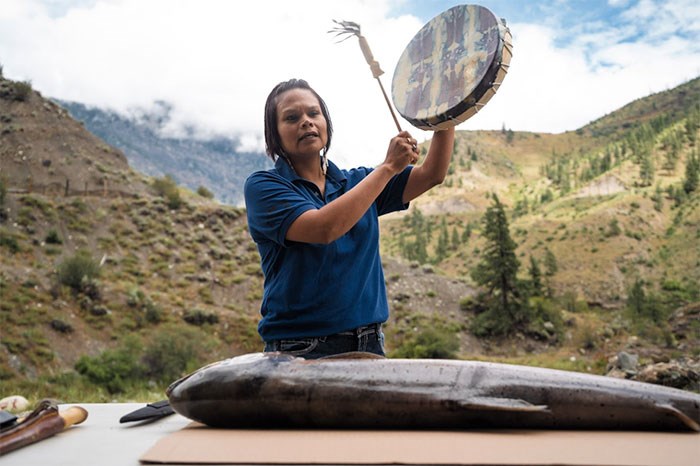 Photo: @ecoescapetravel, provided by Cariboo Chilcotin Coast Tourism Association
Photo: @ecoescapetravel, provided by Cariboo Chilcotin Coast Tourism Association
The historic trail begins at the mouth of the Fraser River in New Westminster, winding its way north to Barkerville, following the traditional trading routes Indigenous peoples’ utilized during the fur trade and expanded upon during the gold rushes of the mid 19th century. Beyond the many lakes, rivers and mountains to explore there are lots of provincial parks, historic sites, indigenous heritage sites, and museums to visit en route along the Gold Rush Trail. Here are some highlights to experience in the fall.
TRAVEL NORTH THROUGH THE STUNNING FRASER CANYON
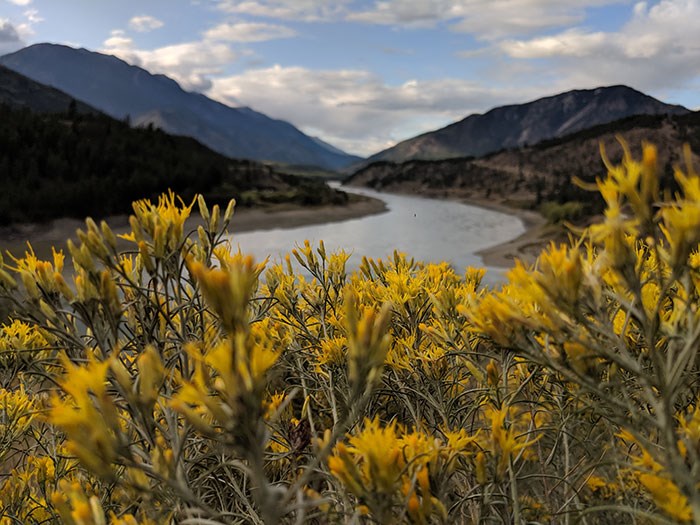 Photo: Kristi Denby, provided by Cariboo Chilcotin Coast Tourism Association
Photo: Kristi Denby, provided by Cariboo Chilcotin Coast Tourism Association
Most travellers take the Coquihalla to begin their excursion into central Northern B.C., but in days past Highway 1 through the Fraser Canyon was the main route. This section of Highway 1 closely follows the path of the Canadian Pacific Railway, offering beautiful views of the railway line and surrounding scenery, including the mighty Fraser river. Gold discoveries in the lower Fraser River Valley near Yale in 1858 and upriver in the Cariboo in 1861 led to a rapid increase in prospectors along the Fraser River, shaping the regions’ culture, landscapes and collective memory.
Stretching over 1,375 km from Fraser Pass in the Rocky Mountains to the Pacific Coast, the Fraser is the longest river in B.C. The Fraser corridor is home to the first recorded settlements of Indigenous people, including the Musqueam, Sto:lo, St’at’imc, Secwepemc and Nlaka’pamux. It was an essential historic route between the Interior and southern Coast and was the primary route of prospectors during the Gold Rush.
Less than 2.5 hours from Vancouver is the deepest, most dangerous section of the Fraser River. Indigenous people have lived along this mighty river for centuries, travelling its waters long before Simon Fraser chartered this river, eventually stating, “no man should ever pass through here. It was truly like passing through the Gates of Hell!”
You have nothing to worry about however, a gondola will transport you across the river where you can walk across the suspension bridge to take a few snapshots of the rushing waters. Please note, Hell’s Gate closes October 21st.
Travel onwards to Boston Bar and finish off in Lytton place of two great rivers, the Fraser and Thompson, where it is famous in the summer for white water rafting. This fall be sure to stop in at the Chinese History Museum and stroll over to Klowa to browse authentic indigenous art and locally made crafts while sipping a cappuccino.
WINE TASTING IN LILLOOET
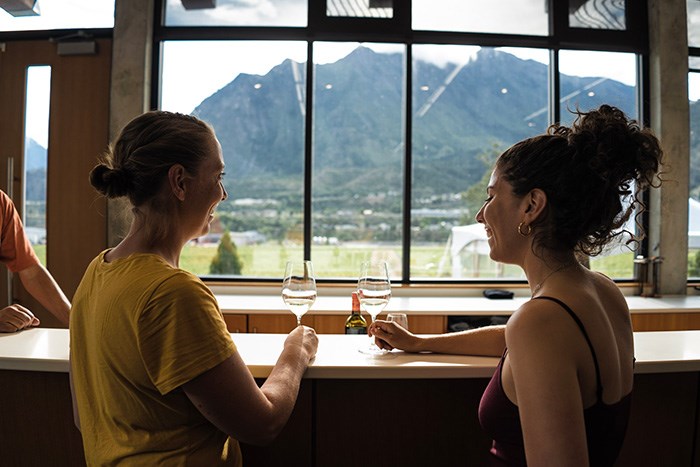 Photo: @ecoescapetravel, provided by Cariboo Chilcotin Coast Tourism Association
Photo: @ecoescapetravel, provided by Cariboo Chilcotin Coast Tourism Association
Lillooet is considered “Mile Zero” of the Cariboo leg of the Gold Rush trail and is the beginning of the famed Cariboo Waggon Road. Be sure to have your photo taken at the Mile ‘0’ marker on Main Street and then stop by Miyazaki House, which was built by one of Lillooet’s early settlers.
If you’re looking to spend more time in nature, the Red Rock hike takes hikers across majestic hillsides of Ponderosa pine into Douglas fir forests, eventually ending to a crimson crag overlooking the town and the Fraser River. This moderately-difficult hike is 3.5 km in length and has an elevation gain of over 500m. After your hike, you can stop at the award winning Fort Berens Estate Winery, as their tasting room is open year-round, or if you are craving a cozy cafe, a warm coffee and a warm pastry stop in at Abundance Bakery. If you’re seeking more adventure, continue on for a stunning drive through the Bridge River Valley with stops in Goldbridge and Bralorne. In these destinations you’ll find horsepacking adventures mountain biking and in the winter action sports like heliskiing
EXPERIENCE FALL COLOURS IN THE CARIBOO
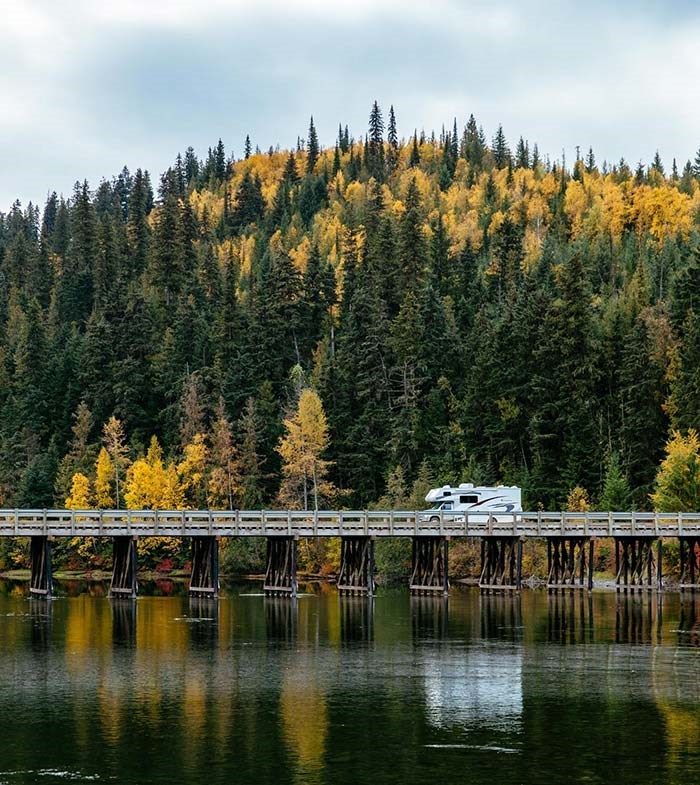 Photo: Jeremy Koreski, provided by Cariboo Chilcotin Coast Tourism Association
Photo: Jeremy Koreski, provided by Cariboo Chilcotin Coast Tourism Association
This time of year the colours of the Cariboo region slowly change from green to stunning shades of red and bronze. While this an incredible site in and of itself, the changing seasons also offer different views and vantage points from which to enjoy the scenery, thanks to the receding summer foliage.
During your stay, be sure to visit some of the hundreds of lakes in the Cariboo, which are particularly bewitching at this time of year. While the nights are cool, the starry sky seems all the more brilliant, with the northern lights paying more frequent visits during the autumn months. Finally, local resorts, lodges and B&B’s throughout the area provide facilities ranging from simple to luxurious, offering something for every visitor of the region. If you want to be out on the water fishing, be sure to check out Fishing BC to help plan all your fall fishing adventures along the Gold Rush Trail.
SUGAR SHACK AT 70 MILE HOUSE
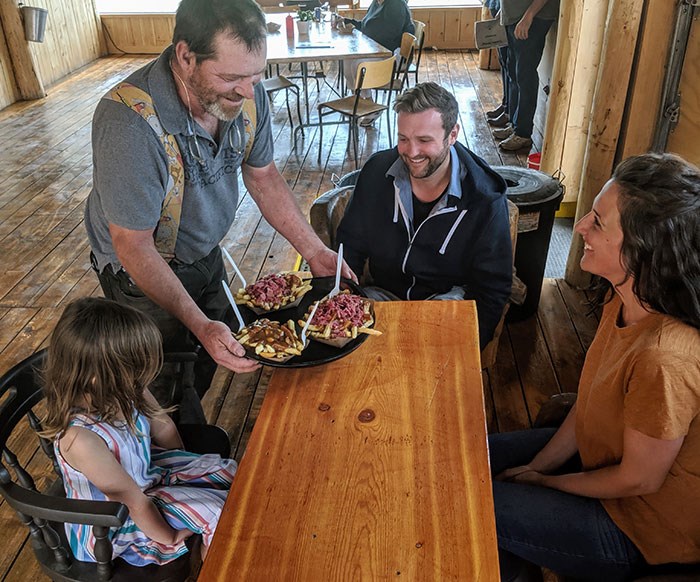 Photo: Kristi Denby, provided by Cariboo Chilcotin Coast Tourism Association
Photo: Kristi Denby, provided by Cariboo Chilcotin Coast Tourism Association
70 Mile House was established in 1862 as a hostel for Cariboo Waggon Road work crews, the area has now evolved into a thriving guest-ranch, outdoor-recreation hub and gateway to B.C.’s Fishing Highway and Green Lake Provincial Park. When in 70 Mile House, you must stop at the Sugar Shack for an authentic French Canadian poutine (self described as the “best west of Quebec”), or to stock up on maple syrup for your journey ahead.
MOUNTAIN BIKE IN WILLIAMS LAKE
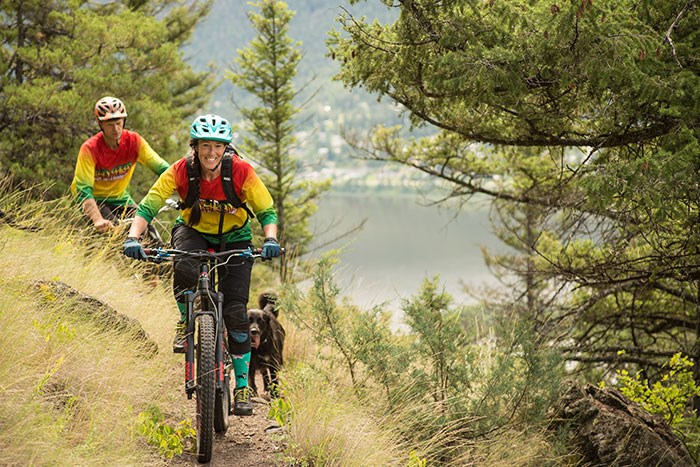 Photo: John Wellburn, provided by Cariboo Chilcotin Coast Tourism Association
Photo: John Wellburn, provided by Cariboo Chilcotin Coast Tourism Association
Williams Lake boasts the largest legal mountain bike trail network in the province covering trails for every style and skill level of rider, from single track progressive free-riding to cross country. With the native foliage transforming into amazing fall colours, this is one of the best times of year to visit Williams Lake. 100 Mile House, Wells and Quesnel are also home to expansive trail networks that should be on your fall list to check out.
THE GHOST TOWN OF QUESNELLE FORKS
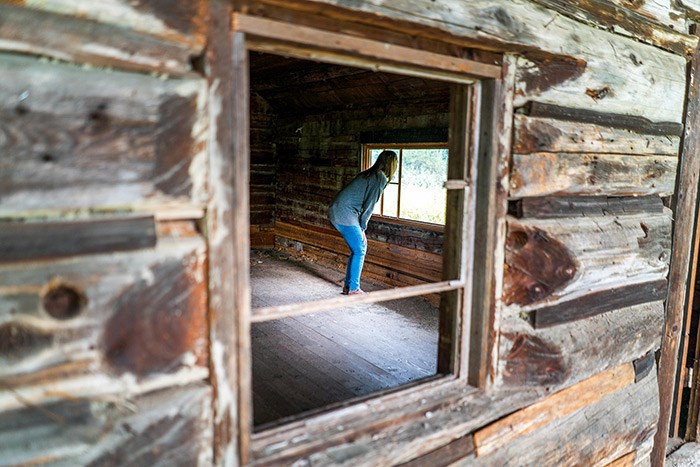 Photo:@tylermcave, photo
Photo:@tylermcave, photo
This unique ghost town is reached by a dirt road only 11km from Likely, B.C. Founded in 1860, Quesnelle Forks was a major supply centre for the Cariboo Gold Rush with the 100 plus residents catering to over 2,000 transient miners and adventurers annually. Today, visitors to Quesnelle Forks can explore the log cabins, pioneer buildings and historic cemetery with no fees or crowds. While in Likely, try a guided river fly fishing trip with Northern Lights Lodge or take an unforgettable bear or wildlife sightseeing tour offered all year round courtesy of Eco Tours B.C.
BACK ROAD TO BARKERVILLE: THE GOLD RUSH CIRCLE ROUTE
Already planning your Gold Rush Trail trip for next year? Looking for an adventure on the road less travelled? Plan a trip on the Gold Rush Circle Route linking Likely and Barkerville Historic Town & Park. This seasonal gravel forestry road (open May to September) winds through the Cariboo Mountains, past stunning waterfalls, an inland temperate rainforest, pristine lakes and the Cariboo River in an alluring backcountry landscape of sub-alpine meadows.
Leading you to Barkerville Historic Town & Park, the Gold Rush Circle Route also features opportunities to explore Gold Rush history and paddle on glacier fed lakes, back dropped by snow-covered mountain ridges. For one of the most spectacular sights of the trip, hike up Cameron Ridge for panoramic views of the Cariboo Mountains and stay the night in a cozy cabin at Cameron Ridge Bungalows.
A PROVINCIAL TIME MACHINE IN BARKERVILLE
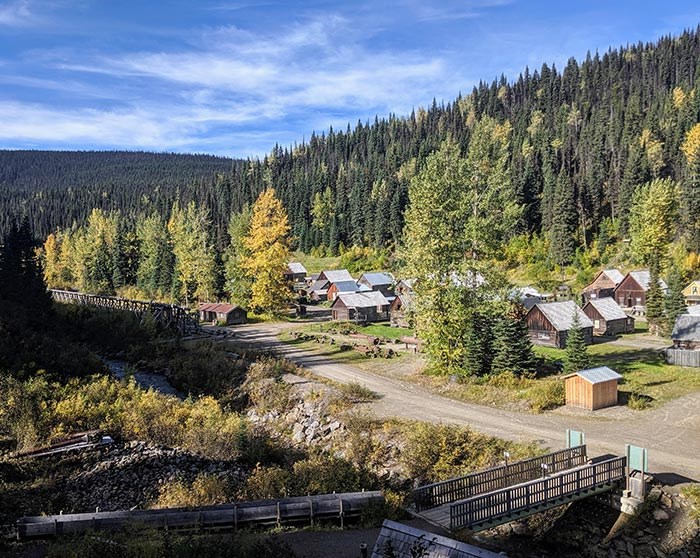 Photo: Kristi Denby, provided by Cariboo Chilcotin Coast Tourism Association
Photo: Kristi Denby, provided by Cariboo Chilcotin Coast Tourism Association
You have reached the El Dorado of the gold rush! In 1862, Billy Barker struck gold in this area of the Cariboo and more than 150 years later, the town of Barkerville is one of Canada’s most significant historic sites. Now a Canadian National Historic Site, Barkerville Historic Town & Park is British Columbia’s best known heritage destination, and the largest historic site in western North America, boasting more than 125 heritage buildings with an additional 62 replicas. During the main season you can tour the town in a stagecoach, interact with costumed interpreters, witness authentic gold rush theatre and indigenous interpretation. September 30th was the last day of the main season of programming, but be sure to check out the special programming all year, including a ghostly Halloween event on October 26th and 27th, a Victorian Christmas event from December 14th - 16th.
Ultimately, the Gold Rush Trail is the story of British Columbia, stretching back millennia into prehistory and before. It is the story of a mighty river and the rich history of civilizations, diverse cultures, languages and traditions that came together long before any of us embarked on its iconic path. This fall, immerse yourself in that history.
To learn more, visit goldrushtrail.ca


